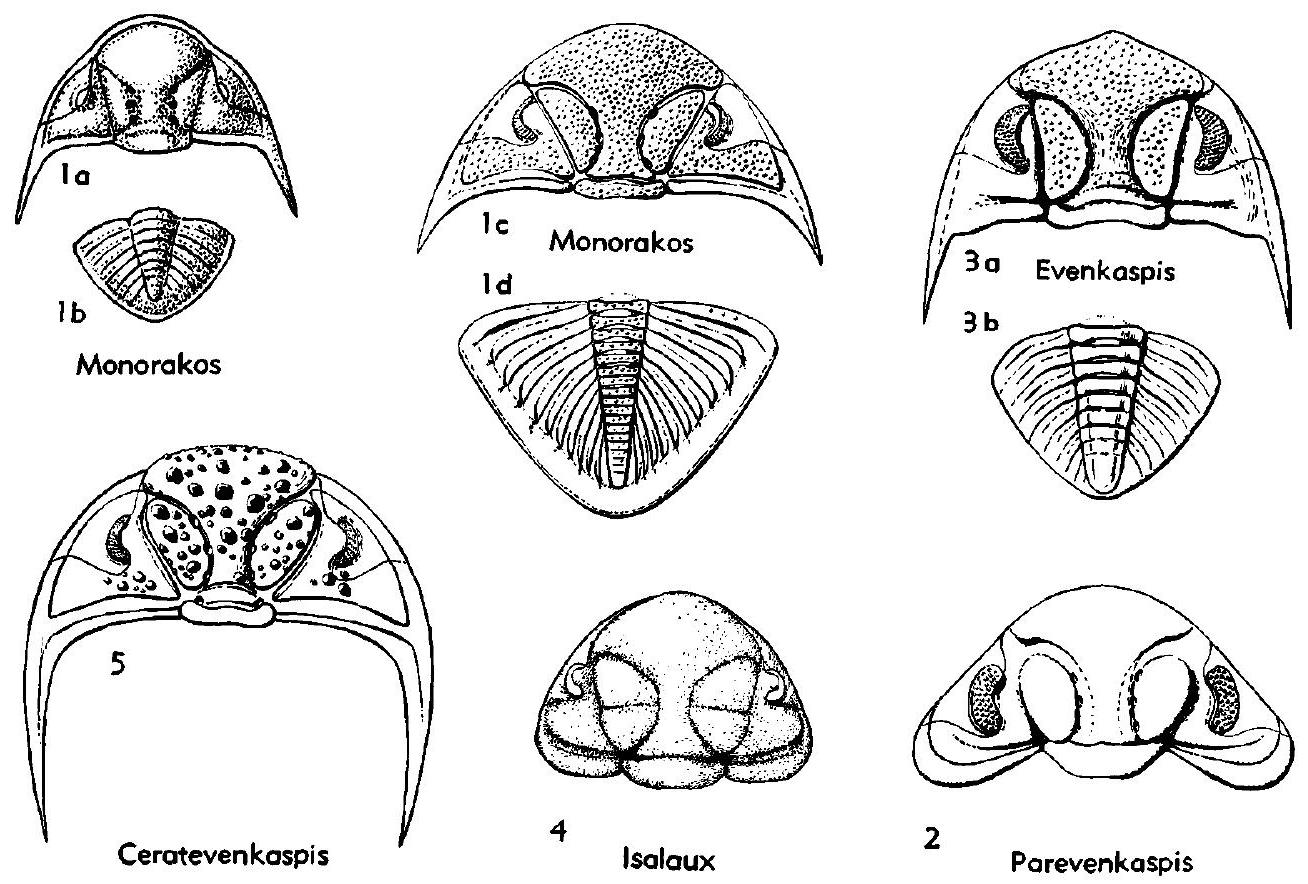Welcome to the Treatise on Invertebrate Paleontology!
Please enter a genera name to retrieve more information.

Isalaux
Classification
Phylum:
Arthropoda
Subphylum:
Trilobitomorpha
Class:
Trilobita
Order:
Phacopida
Suborder:
Phacopina
Superfamily:
Dalmanitacea
Family:
Monorakidae
Formal Genus Name and Reference:
Isalaux Frederickson & POLLACK, 1952
Type Species:
I. cañonensis
Images
(Click to enlarge in a new window)
Fig. 390, 4. *I. canonensis, Harding F. Colo., ceph., x2.5 (400).
Synonyms
Geographic Distribution
C. USA
Age Range
Beginning Stage in Treatise Usage:
M.Ord.
Beginning International Stage:
Dapingian
Fraction Up In Beginning Stage:
0
Beginning Date:
471.26
Ending Stage in Treatise Usage:
M.Ord.
Ending International Stage:
Darriwilian
Fraction Up In Ending Stage:
100
Ending Date:
458.18
Description
Cephalon rather vaulted, with rounded anterior margin, glabella broadening forward, frontal lobe sloping forward steeply, fused with central area to form a single mushroom-shaped lobe similar to Parevenkaspis, 2p and 3p lateral glabellar lobes detached from central area by longitudinal furrows, 2p lobes very hypertrophic at expense of 1p lobes, which are reduced to short wedge-shaped lappets, 1p to 3p lateral glabellar furrows distinct, eyes small with visual surface curved in semicircle, lateral parts of genae steeply sloping, genal angles subangular, without spines. Pygidium rounded triangular with axis reaching posterior margin, about 11 rings, pleural fields steeply sloping, with about 7 pairs of ribs distinct. [Except 2p furrows, the glabellar features of Isalaux are very like those of Parevenkaspis. Despite some similarities to Eomonorachus and closely related forms, Isalaux is more advanced in the trend toward typical Monorakidae. The name Isalaux presumably is a misspelling of Isaulax (Gr., is+aulax, equal furrow) but if so, under the Rules it is not correctable.]
References
Museum or Author Information
Classification
Phylum:
Arthropoda
Subphylum:
Trilobitomorpha
Class:
Trilobita
Order:
Phacopida
Suborder:
Phacopina
Superfamily:
Dalmanitacea
Family:
Monorakidae
Formal Genus Name and Reference:
Isalaux Frederickson & POLLACK, 1952
Type Species:
I. cañonensis
Images
(Click to enlarge in a new window)
Fig. 390, 4. *I. canonensis, Harding F. Colo., ceph., x2.5 (400).
Synonyms
Geographic Distribution
C. USA
Age Range
Beginning Stage in Treatise Usage:
M.Ord.
Beginning International Stage:
Dapingian
Fraction Up In Beginning Stage:
0
Beginning Date:
471.26
Ending Stage in Treatise Usage:
M.Ord.
Ending International Stage:
Darriwilian
Fraction Up In Ending Stage:
100
Ending Date:
458.18
Description
Cephalon rather vaulted, with rounded anterior margin, glabella broadening forward, frontal lobe sloping forward steeply, fused with central area to form a single mushroom-shaped lobe similar to Parevenkaspis, 2p and 3p lateral glabellar lobes detached from central area by longitudinal furrows, 2p lobes very hypertrophic at expense of 1p lobes, which are reduced to short wedge-shaped lappets, 1p to 3p lateral glabellar furrows distinct, eyes small with visual surface curved in semicircle, lateral parts of genae steeply sloping, genal angles subangular, without spines. Pygidium rounded triangular with axis reaching posterior margin, about 11 rings, pleural fields steeply sloping, with about 7 pairs of ribs distinct. [Except 2p furrows, the glabellar features of Isalaux are very like those of Parevenkaspis. Despite some similarities to Eomonorachus and closely related forms, Isalaux is more advanced in the trend toward typical Monorakidae. The name Isalaux presumably is a misspelling of Isaulax (Gr., is+aulax, equal furrow) but if so, under the Rules it is not correctable.]
